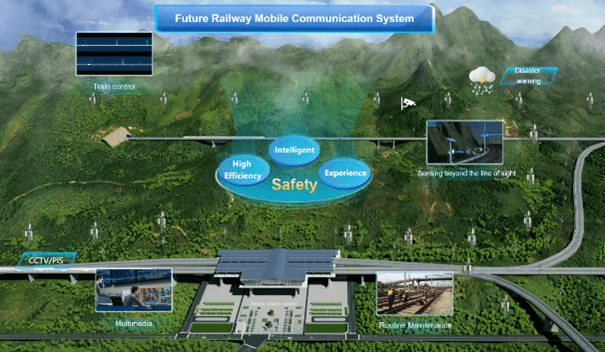At the recent Southern African Railways Association, Huawei revealed how its connectivity solutions are enabling the digital transformation of the railway industry. Its Future Railway Mobile Communication System (FRMCS) solution, 5G Digital Indoor System, and Rail Cloud offerings, in particular, could make for a vastly improved, safer, and more efficient railway experience.
“During SARA 2023, we talked to railway operators and the consensus is that we are all looking for solutions that make railways smarter, safer, more visualised, more efficient, and more reliable,” says Guo Guoqing, President of Huawei Sub-Saharan Africa Enterprise Business, adding that communication technologies will be crucial for their ability to do so.


That’s because the seamless communication of mission-critical data from signaling equipment combined with onboard radio and some video connections can dramatically enhance an operator’s ability to run an effective and safe train service. Delivering this level of connectivity to a train travelling in both rural and built-up locations is by no means an easy task. It is not, however, impossible.
The first step in achieving this kind of seamless connectivity is to accelerate the shift away from traditional UHF and 2G GSM-R telecoms networks that have sustained railway communications for the past two decades. These technologies are steadily becoming obsolete and are now simply unable to handle the demands for bandwidth and data required by a 21st-century railway.
In their place, Huawei says, railways should look to embrace FRCMS solutions. Launched in mid-2019, LTE-based FRMCS is a digital wireless communication system optimised for railways and has been widely deployed in China. The technology supports a 5G-oriented evolution and interconnectivity with GSM-R, which is likely to remain on many networks up to 2025 and beyond. Its advanced features include multiple trunking services such as Mission Critical Push-to-Talk (MCPTT) voice, and data.
The system is highly scalable and flexible, leveraging a single LTE-based FRMCS network to support train control, train dispatching, passenger information system (PIS), CCTV, and other rail services. Together with 5G, the solution will enable a future of intelligent railways where all things are connected.
During the conference, Huawei also demonstrated its capabilities in the 5G space and how they can be applied to the railway sector. Its 5G Digital Indoor System (DIS), for instance, lays the foundation for smart transportation hubs by offering intelligent communications services for a large number of passenger services. For example, the system supports smooth and efficient passenger flow management, security checks, and ticketing services.
In addition, Huawei’s Rail Cloud solution is particularly beneficial to operators of low to medium-capacity networks such as light rail, monorail, and operators that have networks in the low thousands of kilometres. The system converts computing, storage, network, and security resources from physical devices into virtual resource pools on an operator’s own server room or public cloud.
These resources are then allocated to application systems through virtual hosts, virtual network devices, and virtual security devices. The system facilitates the integration of data centre devices while helping to lower device procurement and deployment costs. The system is also suitable for a single suite of rail cloud services, including ticketing, customer care, financing, and maintenance. It additionally supports smooth expansion to converged clouds and rail clouds.
Together, LTE FRMCS, 5G DIS and Rail Cloud offer a comprehensive solution for a reliable connectivity environment demanded by modern railways. These types of technologies are also gaining wide recognition of their importance to the future of the sector.
“High-quality public transport needs a double priority: both physical and digital infrastructure,” said Guo.
SARA President Agostinho Francisco Langa Júnior said in his opening speech, “Our mission is to promote regional trade by ensuring a seamless, predictable, and cost-effective railway system across the SADC region. It is therefore crucial that our railway operators standardise and align in terms of specification to achieve the required interoperability. Safe railway operations hinge upon the robustness of train control technology.”
At the event, Huawei and SARA signed a Memorandum of Understanding (MOU) with the purpose of creating a non-exclusive framework of cooperation for the transformation of the SADC region’s railway transport and corridor logistics to enable seamless, efficient, smooth, cost-effective and quality railway corridor services on all SARA Corridors.

